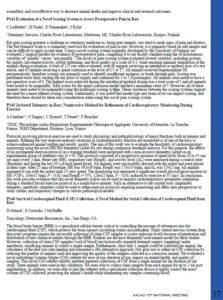A Cambier1,2, S Tanguy1, C Eynard2, T Flenet2, F Boucher1
¹ TIMC, Physiologie cardio-Respiratoire Expérimentale Théorique et Appliquée, University of Grenoble, La Tronche, France;
² R&D Department, Etisense, Lyon, France
23rd AALAS National Meeting, 2022
Abstract
Protocols involving physical exercise are used to study physiology and pathophysiology of major functions both in humans and animals. Refining the way exercise-induced variations in cardiorespiratory function are monitored is of one of the keys to achieve enhanced animal welfare and results’ quality. The aim of this work was to evaluate the feasibility of cardiorespiratory monitoring using the novel DECRO telemetric jacket for rats during continuous treadmill exercise. For this purpose, the effects of an incremental exercise protocol on a training treadmill were monitored with a non-invasive telemetric jacket on an
experimental group of sedentary rats (n = 9). This protocol consisted of a progressive increase of speed level (from 10 to 35 cm/ sec max) every 2 min. Heart rate (HR), respiratory rate (RespR), and activity level (AL) were measured during a control state (Baseline) and during the last 30 s of each speed levels. All animals were successfully dressed with the jacket and were placed in their cage. After 25 min of baseline, HR was 392±36 bpm, RespR was 173±53 brpm, and AL was 15±12 mg. All animals managed to run with the jacket until 35 cm/s speed. The monitoring tool measured a significant overall physiological increase in HR (+26%, 104±21 bpm, P < 0,01) and RespR (+73%, 126±22 bpm, P < 0,01) induced by exercise at 35 cm/s. In conclusion, this work provides evidence that this novel telemetry jacket can be used to monitor cardiorespiratory parameters adaptation during a standard forced exercise protocol in a noninvasive manner. Such an alternative to the current tools (implanted telemetry, metabolic chamber) could be used to refine exercise protocols requiring monitoring and offers new perspectives to study cardiac and respiratory changes in various pathological models.

